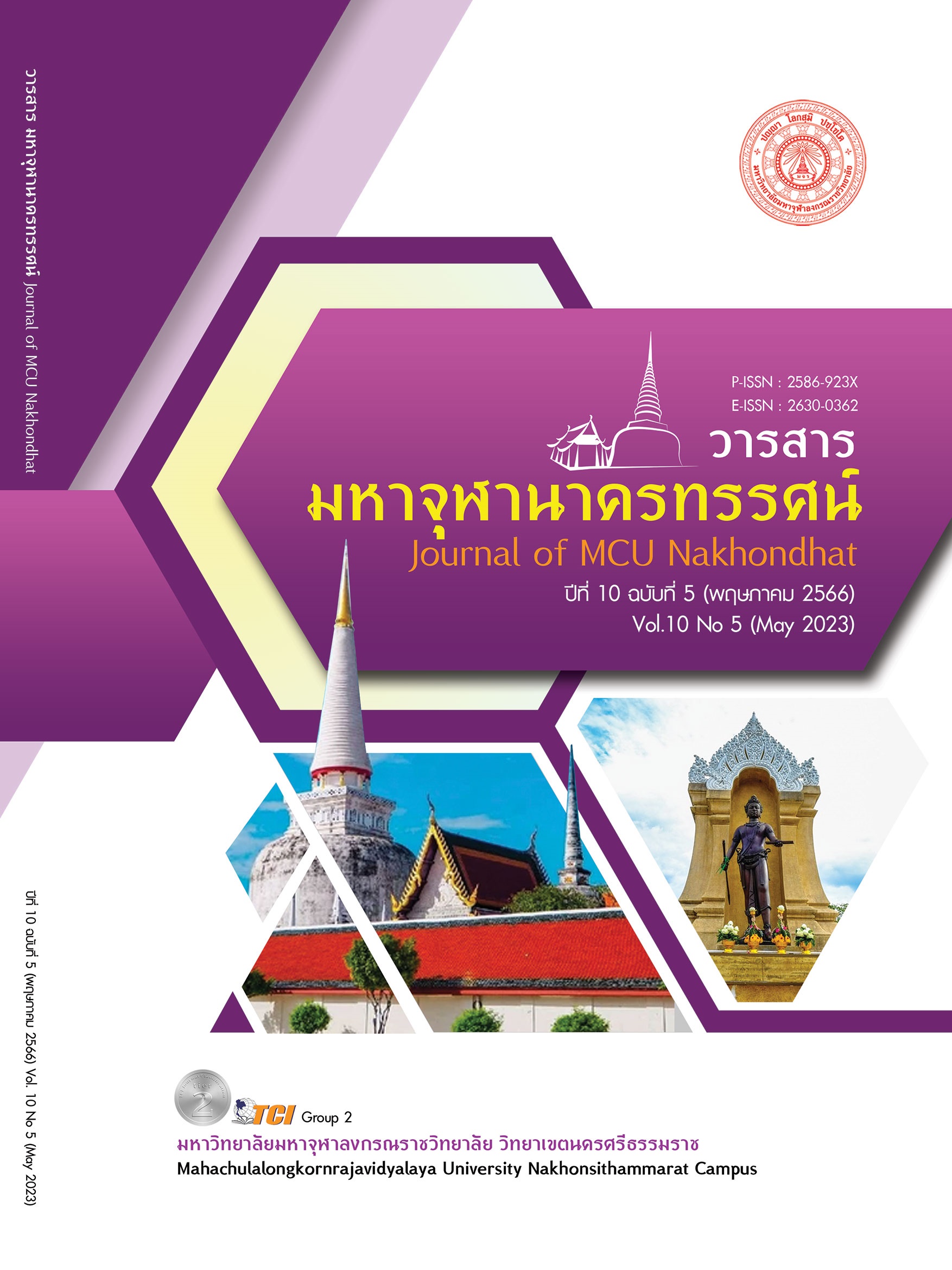THE EFFECTS OF COGNITIVELY GUIDED INSTRUCTION ACTIVITIES ON NUMBER SENSE OF MATHAYOMSUKSA 1 STUDENTS
Main Article Content
Abstract
The purposes of this study are as follows: (1) to compare students’ number sense before and after administrating cognitively guided instruction activities; (2) to compare students’ number sense after administrating cognitively guided instruction activities with the criterion of 70%. The sample of this study included 32 of eighth grade students studying in the second semester of 2022 academic year. They were selected using the cluster random sampling technique. The duration of the research was 14 periods and 45minutes per class. The instruments used in this study were lesson plans and number sense test; objective test there was an index of item – objective congruence (IOC) of 0.67 – 1.00, difficulty (p) of 0.32 – 0.78, discrimination (r) of 0.21 – 0.82 and a reliability of 0.88 and subjective test there was an index of item – objective congruence (IOC) of 0.67 – 1.00, difficulty (P) of 0.22 – 0.50, discrimination (D) of 0.44 – 1.00 and a reliability of 0.90. This research used the One- Group Pretest-Posttest Design. The statistical procedures used for data analysis were a t-test for dependent samples and a t-test for one sample. The results revealed the following: (1) the number sense of the students after experiencing cognitively guided instruction activities were higher than before experiencing the treatment statistically significant at a level of .05; and (2) the number sense of the students after experiencing cognitively guided instruction activities were higher than the criterion of 70%, with a statistically significant level of .05 and an average of 37.38, a standard deviation of 5.79 and amounting to 74.76%.
Article Details

This work is licensed under a Creative Commons Attribution-NonCommercial-NoDerivatives 4.0 International License.
References
กระทรวงศึกษาธิการ. (2563). รายงานผลการทดสอบทางการศึกษาระดับชาติขั้นพื้นฐาน (Ordinary National Educational Testing : O-NET). เรียกใช้เมื่อ 10 ตุลาคม 2565 จาก https://www. secondary28.go.th/?p=2475
จุฬารัตน์ ทองอร่าม. (2556). การพัฒนากิจกรรมการเรียนรู้เพื่อส่งเสริมความรู้สึกเชิงจำนวนและความรู้สึกเชิงปริภูมิ สำหรับนักเรียนระดับปฐมวัย. ใน วิทยานิพนธ์วิทยาศาสตรมหาบัณฑิต สาขาวิชาคณิตศาสตร์ศึกษา. มหาวิทยาลัยอุบลราชธานี.
นพพร แหยมแสง. (2556). พฤติกรรมการสอนคณิตศาสตร์ 1 = Teaching behavior in mathematics 1 : CMA 4101 (TL 461) (พิมพ์ครั้งที่ 2). กรุงเทพมหานคร: ภาควิชาหลักสูตรและการสอน มหาวิทยาลัยรามคำแหง.
นัฐกานต์ พรหมเกษ. (2561). การศึกษาความสัมพันธ์ระหว่างความรู้สึกเชิงจำนวนและความรู้สึกเชิงปริภูมิของนักเรียนชั้นมัธยมศึกษาปีที่ 1. ใน วิทยานิพนธ์ครุศาสตรมหาบัณฑิต สาขาวิชาคณิตศาสตร์ศึกษา. มหาวิทยาลัยราชภัฏมหาสารคาม.
ปวันรัตน์ วัฒนะ. (2559). การศึกษาผลสัมฤทธิ์ทางการเรียนคณิตศาสตร์และความสามารถในการแก้ปัญหาทางคณิตศาสตร์เรื่อง การวัดของนักเรียนชั้นมัธยมศึกษาปีที่ 2 โดยการสอนแนะให้คิด (CGI) ที่เน้นการเชื่อมโยงระหว่างคณิตศาสตร์กับชีวิตประจำวัน. ใน วิทยานิพนธ์ศึกษามหาบัณฑิต สาขาวิทยาการทางการศึกษาและการจัดการเรียนรู้. มหาวิทยาลัยศรีนครินทรวิโรฒ.
ระพีพัฒน์ แก้วอ่ำ. (2559). การใช้คำถามปลายเปิดในการสอนคณิตศาสตร์. วารสารศรีนครินทรวิโรฒวิจัยและพัฒนา (สาขามนุษยศาสตร์และสังคมศาสตร์), 8(15), 206-211.
เวชฤทธิ์ อังกนะภัทรขจร. (2553). การสอนแนะให้รู้คิด (Cognitively Guided Instruction: CGI) รูปแบบหนึ่งของการจัดการเรียนรู้คณิตศาสตร์. วารสารศึกษาศาสตร์, 21(1), 1-11.
สถาบันส่งเสริมการสอนวิทยาศาสตร์และเทคโนโลยี. (2015). รายงานผลการวิจัยโครงการ TIMSS 2015. เรียกใช้เมื่อ 10 ตุลาคม 2565 จาก http://timssthailand.ipst.ac.th/timss/reports/timss2015report
สถาบันส่งเสริมการสอนวิทยาศาสตร์และเทคโนโลยี. (2545). เอกสารเสริมความรู้ทางคณิตศาสตร์ เรื่อง ความรู้สึกเชิงจำนวน (Number Sense). กรุงเทพมหานคร: สำนักพัฒนาธุรกิจ.
สถาบันส่งเสริมการสอนวิทยาศาสตร์และเทคโนโลยี. (2563). ผลการประเมิน PISA 2018: นักเรียนไทยวัย 15 ปี รู้และทำอะไรได้บ้าง. เรียกใช้เมื่อ 10 ตุลาคม 2565 จาก https://pisathailand.ipst.ac.th/issue-2019-48/
สมศักดิ์ ภู่วิภาดาวรรธน์. (2554). หลักการสอนเพื่อพัฒนาผู้เรียนและการประเมินตามสภาพจริง. กรุงเทพมหานคร: ดวงกมลพับลิชชิ่ง.
Hope Jack. (1989). "Promoting Number Sense in School,". Arithmetic Teacher, 36(6), 12-16.
National Council of Teachers of Mathematics. . (1989). Curriculum and Evaluation Standards for School mathematic. Verginia: The National Council of Teachers of Mathematics.
Romau R.N. (1988). "Number Sense Mathematics Teach". Arithmetic Teacher, 81(6), 437-440.


